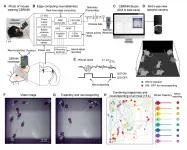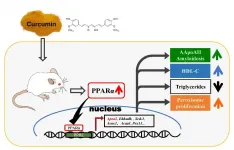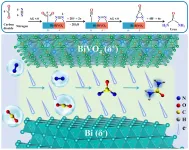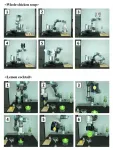(Press-News.org) Epilepsy is one of the most common neurological conditions, affecting more than 65 million worldwide. For those dealing with epilepsy, the advent of a seizure can feel like a ticking time bomb. It could happen at any time or any place, potentially posing a fatal risk when a seizure strikes during risky situations, such as while driving.
A research team at USC Viterbi School of Engineering and Keck Medicine of USC is tackling this dangerous problem with a powerful new seizure predicting mathematical model that will give epilepsy patients an accurate warning five minutes to one hour before they are likely to experience a seizure, offering enhanced freedom for the patient and cutting the need for medical intervention.
The research, published in the Journal of Neural Engineering, is led by corresponding authors Dong Song, research associate professor of biomedical engineering at USC Viterbi School of Engineering and Pen-Ning Yu, former PhD researcher in Song's lab, in collaboration with Charles Liu, professor of clinical neurological surgery and director of the USC Neurorestoration Center. The other authors are David Packard Chair in Engineering and professor of biomedical engineering, Ted Berger, and medical director of the USC Comprehensive Epilepsy Program at the Keck Medical Center, Christianne Heck.
The mathematical model works by learning from large amounts of brain signal data collected from an electrical implant in the patient. Liu and his team have already been working with epilepsy patients with implantable devices, which are able to offer ongoing real-time monitoring of the brain's electrical signals in the same way that an electroencephalogram (EEG) uses external electrodes to measure signals. The new mathematical model can take this data and learn each patient's unique brain signals, looking out for precursors, or patterns of brain activity that show a "pre-ictal" state, in which a patient is at risk of seizure onset.
Song said the new model is able to accurately predict whether a seizure may happen within one hour, allowing the patient to take the necessary intervention.
"For example, it could be as simple as just alerting the patient their seizure is coming the next hour, so they shouldn't drive their car right now, or they should take their medicine, or they should go and sit down" Song said. "Or ideally in future we can detect seizure signals and then send electrical stimulation through an implantable device to the brain to prevent the seizure from happening."
Liu said that the discovery would have major positive implications for public health, given epilepsy treatment had been severely impacted in the past year by the pandemic.
"This is hopefully, going to change the way we deal with epilepsy going forward and it's driven by the needs that have been in place for a long time, but have been highlighted and accelerated by COVID," Liu said.
He said that currently, patients with medically intractable epilepsy-epilepsy that cannot be controlled with medication-are admitted electively to the hospital for video EEG monitoring. With the advent of COVID, these elective admissions completely halted and epilepsy programs across the country ground to a halt over the past year. Liu said this highlights the need for a new workflow by which EEG recordings from scalp or intradural electrodes can be acquired at home and analyzed computationally.
"So we need to create a new workflow by which, instead of bringing patients to the ICU, we take the recordings from their home and use the computation models to do everything they would have done in the hospital," Liu said. "Not only can you manage patients using physical distancing, you can also scale in a way that only technology allows. Computation can analyze thousands of pages of data at once, whereas a single neurologist cannot."
How the Seizure Prediction Model Works
Song said the new model was different to previous seizure prediction models in that it extracts both linear and non-linear information from the patient's brain signals.
"Linear is the simple feature. If you understand the parts, you can understand the whole," Song said. "Whereas the non-linear feature means that even if you understand the parts, when you scale up it has some emergent properties that cannot be explained."
"For some patients, linear features are more important and for other patients, non-linear features are more important," Song said.
Song said that while other models predict brain activity over a short time scale, a matter of milliseconds, his team's model examined an extended time scale.
"The brain is a multi-temporal scale device so we need to understand what happens not just in the short term, but many more steps in the future," Song said.
He said that the model is also unique in that it is patient-specific-it extracts the information that is significant for each individual patient. Because every brain is very different in terms of the signals that indicate a "pre-ictal" state.
"Patients are all different from each other, so in order to accurately predict seizures, we need to record signals, we need to look at a lot of different features and we need to have an algorithm to select the most important feature for prediction," Song said.
"I can't tell you how exciting, this is. At USC we've been very interested in trying to create tools that enhance the public health dimension of these diseases that we're treating, and it's really difficult," Liu said
"Epileptologists are still relatively few in number in many parts of our country and world. While they can identify many subtle features on EEG, the kinds of models that Song can create can identify additional features at a massive scale necessary to help the millions of patients affected by epilepsy in our region and worldwide," Liu said.
Heck, who is also co-director for the USC Neurorestoration Center, said that there are two important issues to the clinical relevance of this technology.
"One is that a majority of patients who suffer from epilepsy live with fear and anxiety about their next seizure which may strike like lightening in the most inopportune moment, perhaps while driving, or just walking in public. An ample warning provides a critical 'get safe' opportunity," Heck said. "The second relevant issue clinically is that we have brain implants, smart devices, that this engineered technology can enhance, giving greater hope for efficacy of our existing therapies."
INFORMATION:
New York, NY (February 26, 2020) - Molecules called microRNAs (miRNAs) that are measurable in urine have been identified by researchers at Mount Sinai as predictors of both heart and kidney health in children without disease. The epidemiological study of Mexican children was published in February in the journal Epigenomics.
"For the first time, we measured in healthy children the associations between urinary miRNAs and cardiorenal outcomes, including blood pressure, urinary sodium and potassium levels, and eGFR [estimated glomerular filtration rate, a measure of how well the kidneys are filtering or cleaning the blood]," says lead author Yuri Levin-Schwartz, ...
Living in a group has clear benefits. As a member of a societal group, one can share resources with the others, seek protection from predators, and forage in an efficient manner. In a 2020 paper published in Science Advances, the neuroscientist Jee Hyun Choi and her student Jisoo Kim of the Brain Science Institute in the Korea Institute of Science and Technology (KIST) argue that there are much more stories about the advantages of group living and social behaviors to the mammalian brain yet to be discovered. Their research was conducted using CBRAIN (Collective Brain Research Aided by Illuminating Neural activity), a unique neuro-telemetric device equipped with LED lights, which enables the ...
Curcumin is a polyphenol compound produced by plants of the Curcuma longa species and has been reported to have many physiological activities, which include anti-oxidation, anti-inflammatory, anti-cancer, and anti-amyloid properties. However, the mechanism and network of action are not completely clear. Amyloidosis is a group of diseases characterized by abnormal aggregates of proteins, known as amyloid fibrils, and subsequent deposition in various tissues and organs, such as Alzheimer's disease, immunoglobulin light chain amyloidosis.
In previous studies, curcumin has been ...
Tohoku University researchers have produced cellulose nanofiber (CNF) synthesized silk naturally through a simple tweak to silkworms' diet. Mixing CNF with commercially available food and feeding the silkworms resulted in a stronger and more tensile silk.
The results of their research were published in the journal Materials and Design on February 1, 2021.
"The idea for our research came to us when we realized the flow-focusing method by which silkworms produce silk is optimal for the nanofibril alignment of CNF," said Tohoku University materials engineer Fumio Narita and co-author of the study.
Silk is usually associated with clothes. But its usage is incredibly diverse thanks to its strength and elastic properties. Its biocompatibility makes it even safe to ...
An open-source platform, OpenEP co-developed by researchers from the School of Biomedical Engineering & Imaging Sciences at King's College London has been made available to advance research on atrial fibrillation, a condition characterised by an irregular and often fast heartbeat. It can cause significant symptoms such as breathlessness, palpitations and fatigue, as well as being a major contributor to stroke and heart failure.
Current research into the condition involves the interpretation of large amounts of clinical patient data using software written by individual ...
The centre is part of the German Federal Institute for Risk Assessment (BfR). With the help of microscopy and artificial intelligence, the "E-Morph" test reliably identifies substances that can have oestrogen-like or even opposing effects, according to the research team's report in the specialist journal "Environment International". "E-Morph is a milestone on the way to, one day, replacing animal experiments currently required to detect hormone-like effects," says BfR President Prof. Dr. Dr. Andreas Hensel.
Link to the specialist publication (ScienceDirect):
https://www.sciencedirect.com/science/article/pii/S0160412021000350
Link ...
A number of brain areas change their activity before we execute a planned voluntary movement. A new study by Umeå University identifies a novel function of this preparatory neural activity, highlighting another mechanism the nervous system can use to achieve its goals.
Voluntary movements are prepared before they are executed. For example, such 'preparation' occurs in the period between seeing a coffee cup and starting to reach for it. Neurons in many areas of the brain change their activity during movement preparation in ways that reflect different aspects of ...
Eminent scientists warn that key ecosystems around Australia and Antarctica are collapsing, and propose a three-step framework to combat irreversible global damage.
Their report, authored by 38 Australian, UK and US scientists from universities and government agencies, is published today in the international journal Global Change Biology. Researchers say I heralds a stark warning for ecosystem collapse worldwide, if action if not taken urgently.
Lead author, Dr Dana Bergstrom from the Australian Antarctic Division, said that the project emerged from a conference inspired by her ecological research in polar environments.
"I was seeing unbelievably rapid, widespread dieback in the alpine tundra of World Heritage-listed Macquarie Island and started wondering if this ...
Converting both nitrogen (N2) and carbon dioxide (CO2) into value-added urea molecules via C-N coupling reaction is a promising method to solve the problem of excessive CO2 emissions.
Compared with huge energy consumption industrial processes, the electrochemical urea synthesis provides an appealing route under mild conditions. However, it still faces challenges of low catalytic activity and selectivity.
A research team led by Prof. ZHANG Guangjin from the Institute of Process Engineering (IPE) of the Chinese Academy of Sciences fabricated Bi-BiVO4 Mott-Schottky heterostructure catalysts for efficient urea synthesis at ambient conditions.
This work was published in Angewandte Chemie International ...
The Korea Institute of Machinery and Materials (KIMM) successfully developed all-round gripper* technology, enabling robots to hold objects of various shapes and stiffnesses. With the new technology, a single gripper can be used to handle different objects such as screwdrivers, bulbs, and coffee pots, and even food with delicate surfaces such as tofu, strawberries, and raw chicken. It is expected to expand applications in contact-free services such as household chores, cooking, serving, packaging, and manufacturing.
*Gripper: A device that enables robots to hold and handle objects, ...





